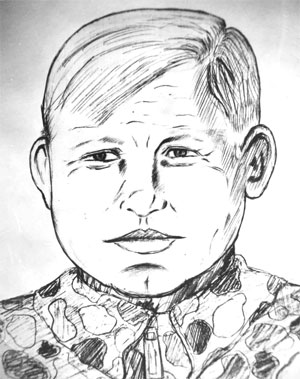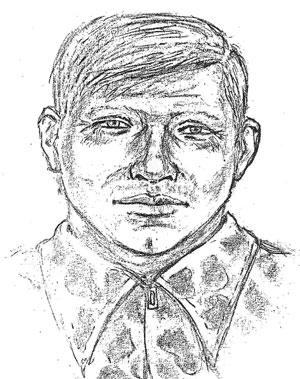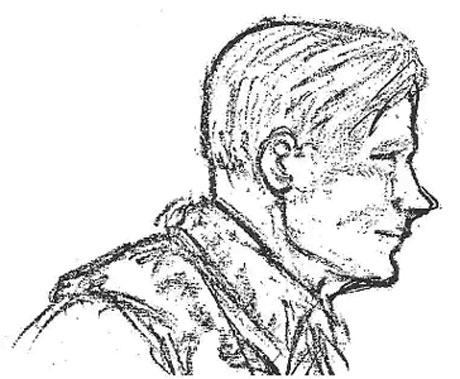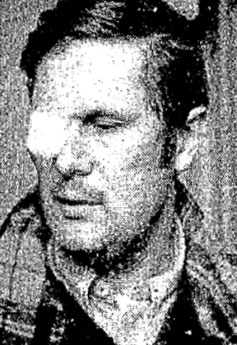Attempted Homicide: The McGowen Shooting
Background
Ever since the Snelling homicide, the Visalia Police Department had regularly been sending out special patrols and organizing stakeouts in an attempt to find the killer, who had continued to burglarize homes and peep at residents in the same small areas of town despite being wanted for murder. On December 10th, 1975, an officer at one of those stakeout locations finally came face to face with the killer.
Pre-Attack Events
February 16th, 1975: Ransacking of Neighbor's Residence
The family that lived next-door to the young woman who would be the Visalia Ransacker's target in this case experienced a ransack-burglary while they were out for the evening. It was at this house that the police would later position themselves during a stakeout to catch the Visalia Ransacker.
July 24th, 1975: Ransacking of Victim's Residence
On this Thursday evening, a nineteen-year-old woman living on West Kaweah Avenue interrupted a burglar coming down from the upstairs apartment that the family had rented out. The man, who was wearing a ski mask, pushed her down as he made his getaway. A few months later, this young woman became away of a peeper outside of her bedroom and bathroom windows. The police advised the family to call them when shoe prints appeared outside of the home.
December 9th, 1975: Shoe Prints Found
Shoe prints were found. The police were called, and they added the home to their list of areas to stake out.
December 10th, 1975 6:00 PM: Stakeout in Place
Officer McGowen positioned himself in the garage of the house next-door to the victim's. His partner was staking out the residence from across the street.
December 10th, 1975 Sometime after 6:30 PM: Ransacking
The Visalia Ransacker burglarized a home on West Laurel Avenue. This location was about half a mile to the south of the home on West Kaweah where the officers were lying in wait.
The Attempted Homicide
December 10th, 1975 8:30 PM
Two and a half hours after getting into a position, a shadowy figure appeared near the garage where McGowen was lying in wait. The subject, moving against the shrubbery in a crouched position, made it to the opening of the garage where the other officer was hiding. The subject stood, peeked inside, and then, apparently not seeing the officer hidden inside, started moving toward the side of the garage and making his way to the back gate. McGowen rose up from his hiding spot and silently began following him.
He followed him to the back gate and observed the subject tampering with the lock for a moment. Then, capitalizing on the element of surprise, he clicked his flashlight on and trained it at the prowler's head.
"Oh my God!" the subject shrieked, spinning around and facing the officer. He squinted in the bright light of the flashlight beam. "Oh no! Oh my God, no!" he cried, his voice high-pitched and frantic.
"Police officer! Hold it right there!"
The suspect, who was wearing something like a stocking cap or ski mask rolled up on his head, reached up and removed it with his right hand. He put it in his right pocket in a distracting manner, and he took off running. Going only a few steps, he used his momentum to propel himself over the gate, landing in the backyard belonging to the house where the officer had hidden in the garage.
"Hold it! Put your hands up!" the officer ordered, also jumping over the fence. The suspect began running around in the yard, almost in a zigzag or circular pattern. "Oh my God! Please don't hurt me! Oh my God, no!" he continued to scream in a high-pitched, feminine voice.
The officer fired his service weapon into the ground far away from the suspect to act as a warning shot and to alert his partner across the street to the confrontation. The partner had already observed the subject and was on his way.
Shortly after the weapon discharged, the prowler ran straight for the fence bordering the next yard, and he easily scrambled over it. He landed squarely in the yard where his shoe prints had been observed the day before.
"Police officer! I told you to put your hands up! Stop or I'll shoot!" the officer warned him. He continued to track the subject through the wide spaces between the fence slats with his flashlight. He held the flashlight up and away from his body like he'd been trained to do.
"Don't hurt me! Oh my God! Please don't hurt me!" the man continued to shriek. He stopped running, positioning himself only five feet away from the officer. He then turned to his side so that only the right half of his body was exposed to the officer.
"Look! My hands are up!" he squealed as he raised his right hand. As he did this, he began digging around in his jacket with his left hand.
Before the officer could react, the subject spun to face him and fired a shot. The policeman fell backwards from the force of the impact. As his partner arrived at his side to assist, he saw the officer lying motionless on the ground. His partner radioed for help as he watched the shooter run through the gate on the other side of the fence.
Meanwhile, the homeowner, his wife, and two visitors at the target house heard the gunshot. The homeowner looked out his window just in time to see a man run through his back gate. He charged out after him and quickly caught sight of the man, who by this time was walking (not running) next to the fence on the other side of the house. The shooter turned and looked at the homeowner, seemed to pause a moment, then took a running start and jumped through some hedges that ran along the side of the yard.
Immediate Aftermath
Back on the other side of the house, the officer who had confronted the subject pulled himself to his feet. Luckily, it was learned that the bullet had hit his flashlight directly in the lens, and other than some debris near his eye and some powder marks on his face, the policeman was relatively unharmed. He was transported to the hospital, where he was later treated and released.
On his way out of the yard, the shooter had emptied his pockets of the loot that he had stolen at the West Laurel ransacking that night. The money and coins he'd stolen were found tied up in a sock on the ground. A few books of Blue Chip stamps, also stolen at the ransacking that night, were found as well. He also left a copious amount of shoe prints that matched other Visalia Ransacker scenes.
Every on-duty Visalia Police Department unit was called in, all off-duty personnel were called in, the California Highway Patrol was called, and the Tulare County Sheriff's Office was also called in. Nearly seventy officers descended on the area.
Some of the officers congregated at the hedges where the Visalia Ransacker was last seen. Officers unfamiliar with the offender got a read on his shoe prints. Impressions were found in the dirt and in flower beds, and the tracks themselves were found on the patio.
Shoe prints were tracked six houses to the west of the shooting location, and they appeared to hook north up South Divisadero Street. There was a small break in the tracks, and then they were picked up again the site of a house under construction on West Noble Avenue. The tracks seemed to vanish a bit, but an officer noticed a few more two or three houses to the west of the corner of Divisadero and Noble. It appeared that the shooter had traveled west from the scene of the shooting, gone one block north, and was now headed back west.
The tracks were a bit more visible at this point, and it appeared the Ransacker had run alongside State Route 198. A next of crushed branches, leaves and shoe prints pointing various directions indicated that the Ransacker had hidden himself near a palm tree across from the corner of West Noble Avenue and South Dollner Street. Interestingly enough, if you visit Visalia today, that palm tree is still there, one of the only surviving eyewitnesses to the chase.
Another officer found more shoe prints heading east behind houses near West Noble Avenue and South Giddings Street. A few were found on the east side of Giddings (where now sits the Pentecostal Lighthouse Church). The police realized too late that this area was outside of the perimeter that they had set up — the Ransacker had foiled them by retreating in the opposite direction that he had taken off in initially.
Some officers theorized that the Ransacker had crossed the highway into the north section of town on foot using Giddings Street, thus getting even further outside of the perimeter. A tracking dog was brought to the scene, and the dog's trail ended virtually at the same area that the officers did. Modern thinking is that he probably had transportation near the church, either a bicycle or a car, and he was able to elude the dogs and the police officers by fleeing the scene using a method of transportation.
In the end, the search for the shooter that night was a failure. Once again, the Visalia Ransacker had evaded capture and melted into the night.
Suspect Description
McGowen described the shooter as a white male, 25 to 35 years of age, 5'10", and 180 pounds or more. He had a round face, a cleft in his chin, a wide jaw, and his nose had a distinctive shape when the offender's profile was seen. He had a "thick neck."
His hair was short, light blonde, with no sideburns. It was longer on the top and parted on the left side. The officer described it as a "military haircut," as it was shorter than most boys and men were wearing.
He had light skin with no sign of whiskers or stubble. Under hypnosis, the officer described him as "babyfaced."
The officer described the Ransacker's shoulders as large and round, and he had a larger lower half with large legs, large hips/thighs, and a large behind (or "rump," as the report puts it). His feet were described as "stubby."
The VR was wearing tight pants that looked like blue jeans, a brown and green camouflage jacket with elastic cuffs, converse tennis shoes that were a low-top style and dark in color, and brown cotton gloves. The cap he was wearing was very thick, and it gave the impression of a ski mask rolled up.
He described the shooter as running slowly and running in a "funny manner, like his knees were together." This may be because of eleven pounds of loot that he had in his pockets, or it could be indicative of a strange gait that was sometimes described by witnesses.
He drew his gun and shot with his left hand.
The neighbor who observed the subject described him as 5'10", about 180 lbs, and being "large," having a "large frame."
A month and a half later, after the VR case had started to grow quiet, another officer created a sheet that summarized and collated a bunch of Visalia Ransacker facts. In this description, the officer is said to give the age range of "20-25," and the detail of "short, stubby fingers" was added. The officer who compiled the new list of information said that the "stubby fingers" was actually taken from the Snelling description and was misattributed. The new age range was an amalgamation of the various descriptions given by witnesses over the crime spree.
A composite drawing was made of the suspect, featured below:

About a month later two more drawings were done — one of the perpetrator's face and one of his profile:


Unfortunately, the officer passed away a number of years ago, so what the VR really looked like that night will only be known when and if he's identified.

The Victim: William McGowen
Officer McGowen was a member of the Visalia Police Department for many years. This photo shows the officer with a patch over his eye - thankfully, the only damage done to him during his encounter with the Visalia Ransacker.
McGowen went on to retire from VPD after a full and honorable career, and he continued to work on this case even into retirement.
<- Previous | Index | Next ->
